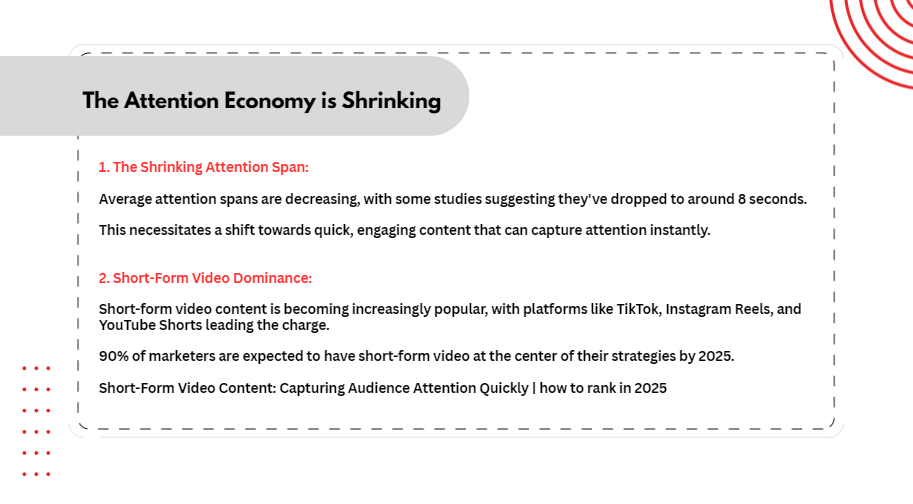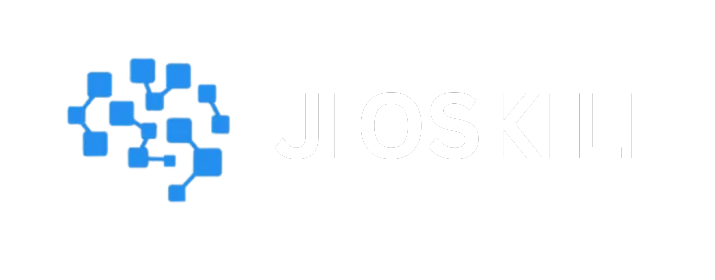Currently Empty: ₹0.00
Short-Form Video Content: Capturing Audience Attention Quickly | how to rank in 2025
Short-Form Video Content
Problem: The Attention Economy is Shrinking
People’s attention spans are rapidly decreasing. The average human attention span decreased from 12 seconds in 2000 to barely 8 seconds in recent years, per a Microsoft study. Short-Form Video Content.This implies that marketers and content producers have less time than ever to leave a lasting impression.
People anticipate instant gratification and scroll and skip more quickly in today’s digital age. While long-form material still has its place, you’re probably losing out on a sizable portion of the internet audience if you’re not using short-form video content.
In actuality, YouTube Shorts, Instagram Reels, and TikTok are now ecosystems rather than merely platforms. They influence consumer behavior, trends, and culture. Short-Form Video Content, In 2025, producing speedy, powerful content that ranks is more important for online success than simply producing excellent material.
But here’s the challenge: With so much short-form video flooding every platform, how do you actually stand out and rank higher in search and algorithms?
Agitation: Posting Isn’t Enough Anymore

The majority of brands and creators believe that the secret to success is posting often. They record a 15-second video, add a popular song, and press publish. After that, they wait for the views to come in.
Hope, however, is not a tactic.
Short-form channels face greater competition than ever in 2025. Every day, more than 34 million new videos are published to TikTok alone. In 2024, Short-Form Video Content,YouTube Shorts received over 70 billion views every day worldwide. Every month, more than 2 billion people use Instagram Reels.Short-Form .
This implies that your material is up against everyone, not just regional producers.
Algorithms do not prioritize content based on quality, even if your video is excellent.
- Viewer retention (the amount of time spent watching)
- Rewatch rate (the frequency with which viewers return to your clip)
- Engagement (likes, comments, shares, and saves) per second
- Titles, descriptions, captions, and hashtags are examples of SEO metadata.
- Performance on multiple platforms (if your video works on various apps)
So just hitting record and uploading isn’t enough. You need a real strategy to make short-form video work for you.
Solution: A Data-Driven System to Rank and Retain Attention
Let’s break down a system that actually works. No gimmicks. Just tactics based on results.
Step 1: Hook in the First 1.5 Seconds
Yes, you read that right. Not 3 seconds. Not 5. You have just 1.5 seconds to hook someone.
According to TikTok’s internal data, videos that hook users in the first 1.5 seconds see 148% higher completion rates.
How to hook effectively:
- Start with movement or a visual change.
- Use a big facial expression or hand gesture.
- Ask a question or show something out of the ordinary.
- Use text overlays that immediately signal value or mystery.
Bad Example: Starting with a long intro or logo. Good Example: “This $10 hack saved me $2,000.”
Step 2: Deliver Value Immediately
If you’re promising something, deliver it fast. People don’t want to wait to see the punchline. Whether it’s a tip, story, or hack, get to the point.Short-Form Video Content: Capturing Audience Attention Quickly | How to Rank in
In 2023, HubSpot ran a study comparing short-form videos across niches. They found that videos that delivered the core message in the first 5 seconds had 80% higher share rates.
Tactics:
- Deliver on your promises as soon as possible. The punchline is not something people want to wait to see. Get right to the point, whether it’s a story, hack, or tip.
- HubSpot conducted research in 2023 comparing short-form films from various niches. They discovered that the sharing rates of videos that conveyed the main point within the first five seconds were 80% higher.
- Strategies:
- Put your greatest material first.
- To maintain visual interest, use cuts every one to two seconds.
- Anything that seems like filler should be removed.
Step 3: Use SEO Metadata Like a Blog Post
YouTube Shorts and Instagram Reels now use AI-driven search features, meaning your titles, descriptions, and hashtags directly impact discoverability.
Treat every video like a mini blog post.
Checklist:
- Title: Use keywords naturally (e.g., “3 Tips to Edit Videos Faster”)
- Description: Add a clear 1-2 sentence summary of the video.
- Hashtags: Mix broad (e.g., #marketing) and niche (e.g., #CapCutTips2025) tags.
- Captions: Always include on-screen captions; 85% of viewers watch without sound.
Step 4: Build a Retention Loop
Retention is the #1 factor algorithms care about. A video with 90% retention will beat one with millions of views but only 30% retention.Short-Form Video Content: Capturing Audience Attention Quickly | How to Rank in 2025
How to build a loop:
- End the video mid-action (“Wait until you see this…”)
- Use cliffhangers or part 2 hooks.
- Have fast pacing that makes viewers rewatch.
- Loop audio so it restarts cleanly when the video ends.
Step 5: Post Consistently, Not Randomly
Posting daily won’t help if your content has no focus. Instead, develop content pillars and stick to them. This trains the algorithm to associate your profile with specific topics.
Example: A creator focusing on digital marketing might have:
- Tips & Hacks (Mondays)
- Case Studies (Wednesdays)
- Personal Insight or Opinion (Fridays)
Stick to your pillars for at least 30 days. The algorithm needs pattern data to push your videos to the right audience.
Case Study: The Rise of Alex Hormozi’s Short-Form Empire
Let’s talk about real results.
In 2023 and 2024, entrepreneur Alex Hormozi exploded on TikTok, YouTube Shorts, and Instagram Reels. His short-form content consistently racked up millions of views and helped him build a massive audience in under 18 months.Short-Form Video Content: Capturing Audience Attention Quickly | How to Rank in 2025
What He Did Right:
- Every video featured a hook, a promise, and an immediate delivery of value. No nonsense.
- Repurposing Content: He cut lengthy podcasts into more than 20 brief segments. Twenty pieces of material were created from a single video.
- Effective Hook Phrases: He frequently begins with statements such as “Most people do this wrong” or “This is what I discovered after losing millions of dollars.”
- SEO Mastery: Each video was given a blog post-style title. The descriptions were full ofjio keywords. The hashtags were specific.
- Face-Forward Branding: His videos were instantly identifiable due to his distinctive style, which included a white tank top, direct eye contact, and no distractions.
Results:
- Over 5M followers across platforms
- 200M+ combined views on short-form clips
- Generated 8 figures in leads without ad spend
Bonus: Tools and Apps That Give You an Edge
Speed and consistency matter. Here’s a shortlist of tools creators use to optimize their short-form strategy:
Editing & Captions:
- CapCut (Free, TikTok-native)
- Descript (AI editing + auto-captions)
- Veed.io (Web-based, great for teams)
Idea Generation:
- Glasp or ChatGPT (for summarizing long videos into clip ideas)
- TikTok Creative Center (for current trends by region)
- AnswerThePublic (for search queries and hooks)
Scheduling & Analytics:
- Metricool or Later (cross-platform scheduling + data)
- TikTok Creator Center & YouTube Studio (for retention graphs and audience insights)
Final Thoughts: 2025 Is the Year of Precision, Not Just Presence
Short-form video isn’t a trend. It’s the present and future of content marketing. But just showing up isn’t enough. You need precision.
In 2025, the creators and brands that win won’t be the ones who post the most. They’ll be the ones who:
- Hook fast
- Deliver faster
- Optimize for discoverability
- Build retention loops
- Show up with strategy
Don’t let your videos drown in the noise. Build a system. Follow the data. And capture attention before it scrolls away.
Because in the battle for attention, milliseconds matter.
1. In 2025, why is short-form video material so successful?
The reason for this is that people are consuming content more quickly than ever before and their attention spans are getting shorter. Quick, interesting, and simple-to-digest content is rewarded on platforms such as Instagram Reels, YouTube Shorts, and TikTok. Short-form videos are quick, scrollable, and mobile-first, which is how people currently consume content.
2.How long should a short-form video be?
Response: Don’t go above 15 to 45 seconds. For maximum engagement, TikTok suggests less than 30 seconds. Although YouTube Shorts allows for up to 60 seconds, research indicates that videos that are well retained for less than 30 seconds typically rank higher and receive more recommendations.
3.How significant are a short-form video’s opening moments?
Everything is involved. You have one and a half seconds to grab the audience’s attention. If they don’t find it immediately interesting, they will scroll past. To capture attention, effective designers employ abrupt movements, startling claims, or intriguing queries.
4.Which types of content are most effective for short-form videos?
content that quickly provides entertainment or obvious value. Examples include: – “How to” advice – Short tutorials and hacks – Behind-the-scenes looks – Bold viewpoints or unconventional approaches – Mini case studies or data insights – Humorous or relatable tales.
5.How can I increase rewatch rates and video retention?
Remove the filler. Every second ought to matter.Employ pattern disruptions, such as text changes, zooms, and scene changes.Finish with a cliffhanger or an open loop.Cleanly loop background music to ensure a smooth video restart.Throughout, pique viewers’ interest to make them want to watch again.
6.Will hashtags still be important for short-form videos in 2025?
Yes, but make good use of them. Use a combination of: – Platform-specific trends (#foryou, #shorts, #reels) – Broad tags (#marketing, #fitness) – Niche tags (#salesfunnels2025, #filmmakinghacks)ThisWhen used with SEO-optimized headers and captions, hashtags aid the algorithm in classifying your content.







